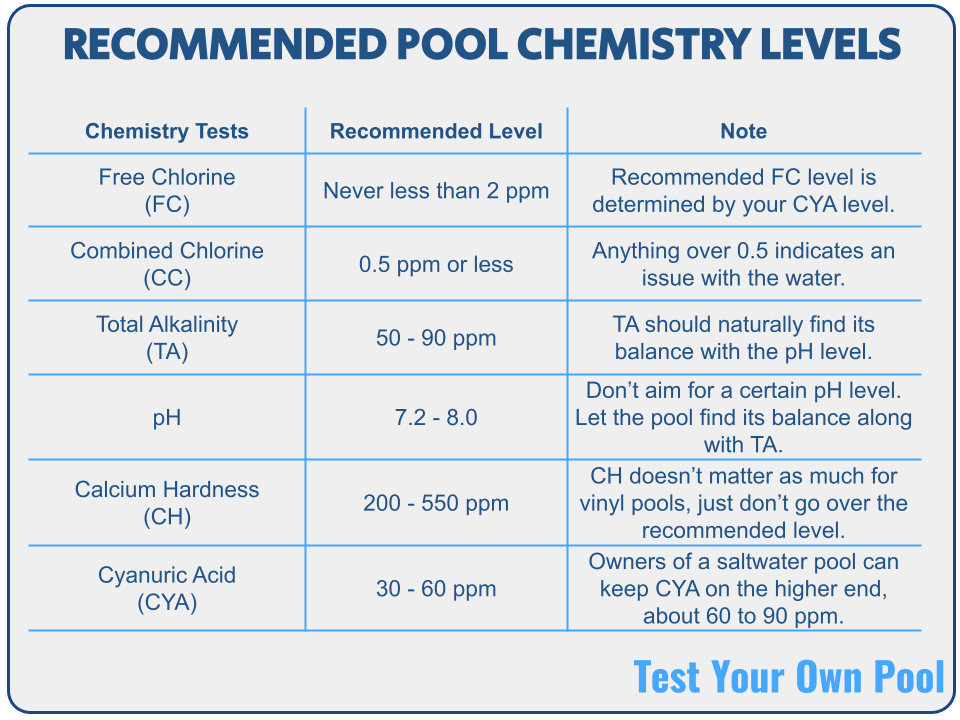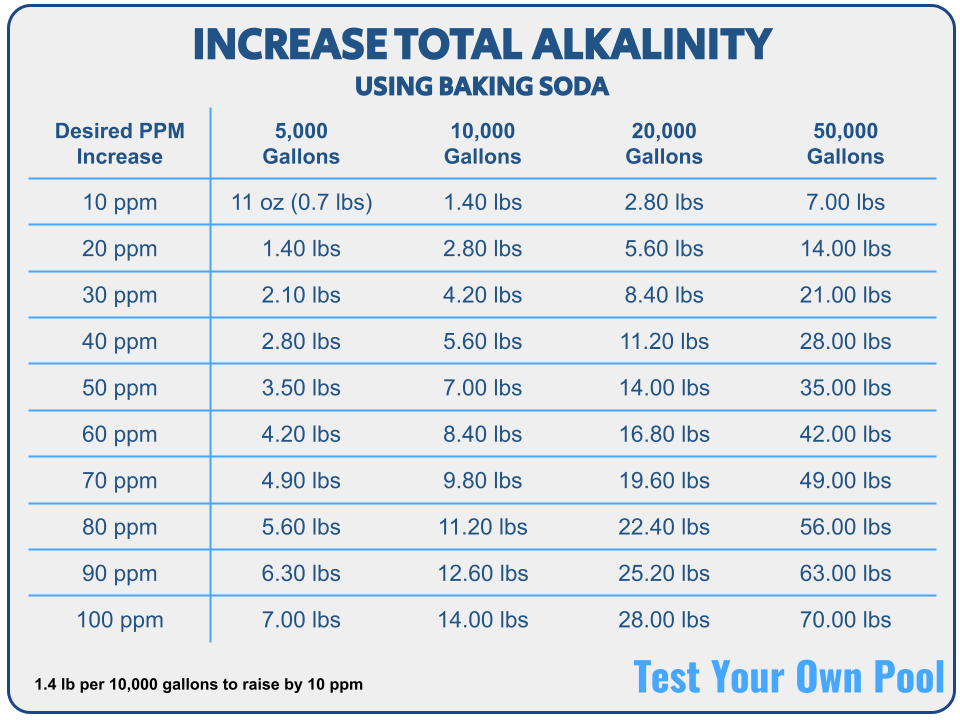Muriatic acid is a less-pure variation of hydrochloric acid. It’s not necessarily something that you’d think of as an important pool chemical.
This doesn’t take away from the fact that it is still a highly corrosive acid. You should know not only why it is a helpful pool chemical but also how to use and handle muriatic acid for your pool safely.
What Does Muriatic Acid Do For The Pool?
Primarily, muriatic acid is used in the pool to lower pH and total alkalinity (TA). However, it can also be used to clean tile grout lines and stains, as well as clean your deck area and acid wash a pool’s surface if necessary.
Lowers Both pH and Total Alkalinity
Muriatic acid’s most valuable use is to lower the chemistry levels of pH and total alkalinity (TA). pH is the general measurement of the acidity or basicity of pool water, while TA acts as pH’s “buffer” and resists wild changes in pH caused by the water.
A pool with high pH and TA can cause scaling, eye and skin irritation, and circulation reduction, so keeping these in check is critical.
Because muriatic acid has a pH of about 1 – 2, it is a great solution to maintain chemistry balance. pH should be around 7.2 – 8.0 and TA around 50 – 90 ppm.

While both levels decrease with the use of muriatic acid, they don’t lower at the same rate. If using acid at 31.45% strength, a 10 ppm decrease in TA will cause a .6 decrease in pH.
That is a pretty significant impact on pH, so water testing becomes very important in this case. It also should be known that TA can be raised with baking soda, so lowering the pH to proper levels and then raising the TA back up with baking soda is a common practice (which can turn into a game of cat and mouse pretty quickly!).
Jump to the below section to understand how much muriatic acid is needed based on your pool.
Cleans Pool Tiles and Deck Stains
Muriatic acid is a great way to remove any stains on pool tiles. Over time, tiles can fade, and mineral calcium and magnesium deposits can form on the tile.
A very diluted mixture of muriatic acid and water can help return those pool tiles to their original state.
It can also help with pool decking stains and rust marks from grills or pieces of furniture. Again, using a diluted mixture can bring back that bright shine a new deck usually provides.
Acid Washes
Over time, plaster surfaces can build up grime, stains, and calcium deposits that require professional cleaning. An acid wash is a cleaning procedure using a mixture of muriatic acid and water to spray onto the pool surface and help remove that build-up.
It essentially removes a small layer of plaster to minimize or remove stains and other ugly objects on the surface.
The Benefits of Muriatic Acid vs. Alternatives
The thought of handling muriatic acid for your pool can be intimidating. There are other alternatives to use that will lower pH and TA.
Dry acid, or sodium bisulfate, is the most popular substitute for muriatic acid. It’s much easier to handle as it comes in granular form and is sold in most pool stores as pH minus or pH decreaser.
However, dry acid also adds sulfates to the pool. Excess sulfates in the water can cause damage to plaster surfaces, corrosion of metal parts, and degrade saltwater generator parts. Because of this, dry acid should not be used in plaster or saltwater pools.
Muriatic acid is also usually much cheaper based on a per dosage basis. When bought at a local store, a 1-gallon jug of 31.45% strength can cost about $8 to $12.
Where to Buy Muriatic Acid?
Since muriatic acid is helpful in many fields and disciplines, it can easily be found in almost all big box and hardware stores. The only difference would be in the location.
Klean Strip Green Muriatic Acid used to lower pH and TA in swimming pools.
Sometimes, it can be found in the paint section, while it can also be located in the garden section or building supply aisles.
Most stores will have various strengths of muriatic acid on hand, usually at 15.7% or 34.17%. If available, go for the higher strength as it will require less per dosage.
Safely Handling and Storing Muriatic Acid
If it wasn’t obvious, you will be dealing with acid. It is very corrosive and can damage your health if not handled properly and you are being careless.
However, taking the proper precautions allows muriatic acid to be used safely and effectively. Consider these safety measures when handling:
- Wear proper PPE. Safety glasses, resistant gloves, and a mask or respirator are highly recommended when handling muriatic acid. Consider wearing long sleeves as well. If inhaled, the smell is quite powerful, so a mask will help mitigate the fumes.
- Pour muriatic acid into water, not the other way around. You never want to mix water into a chemical as it can splash onto the decking or on yourself. Whether you are applying directly into the pool or an acid-resistant jug, make sure to pour slowly.
- Wait about 15 minutes between adding muriatic acid and another chemical. Chlorine and muriatic mixed can form a toxic gas that is dangerous even in small doses.
Properly storing the remaining muriatic acid is also an important measure of overall safety. Follow these guidelines for safer storage:
- Keep it in the same container it came in. Muriatic acid was put into its container for a reason. There is no need to move it to another container.
- Store outside or in a well-ventilated area, not in a garage! You can store your muriatic outside, just make sure that it is always shaded and not directly hit by the sun. If storing in a wood shed or barn, make sure that it is properly ventilated. Since muriatic acid’s fumes can and will rust metal, it should not be stored in a garage or other areas that contain metal surfaces.
- Do not store around other chemicals. Never store muriatic acid near chlorine or other pool chemicals
How Much Muriatic Acid Is Needed?
To know how much muriatic acid is needed and how it will affect both pH and TA, we should be as accurate as possible. This pool calculator does a great job to determine your recommended dosage based on pool volume and current pH and TA levels.
If you need some help understanding how many gallons your pool holds, use this pool volume calculator.
Depending on the pool testing kit used, most will have dosage instructions for pH based on the acid demand test. For Taylor-based tests, one drop of acid demand reagent in a 10,000-gallon pool is equal to 9.16 fluid ounces of muriatic acid.
How to Use Muriatic Acid to Lower pH and TA
Now that the basics and safety measures have been taken, it’s time to use muriatic acid to lower pH and TA. Follow these simple steps and follow up with additional testing.
1. Test Your Water To Get Current Levels
First, you need to know your current pH and TA levels. It’s best to get the most accurate result possible so a liquid-based testing kit is highly recommended.
Once you have current readings (and they are higher than the recommended ranges), it’s easier to know how much muriatic acid to pour into the water.
2. Know How Much Muriatic Acid to Add
Use the calculator above to determine exactly how much muriatic acid to add based on the % strength that you have on hand and pool volume.
To make it easier, download Pool Math app. It is much easier to understand and you can better focus on one chemistry level at a time.
3. Add Muriatic Acid to the Deep End
Remember to wear proper PPE when handling the muriatic acid. For this step, you can either add directly into the pool or dilute the acid in a bucket prior to pouring. If diluting, a good ratio of water to acid is about 10:1.
No matter which way you add it, you’ll want to follow these steps:
- Make sure the pool pump is running and water is properly circulating. The pump should be on for the entire process
- Head to the deep end of the pool. You’ll also want to pour directly in front of a return jet to ensure quick dispersion of acid.
- Slowly pour the measured-out muriatic acid (either in a measuring cup or with the diluted bucket) into the pool. Pouring slowly ensures no acid splashes out onto the decking, coping, or yourself.
4. Test Water Again for Updated Results
After about 30 minutes to an hour, retest your pH and TA levels. If they still are not in range, repeat the process until you are satisfied with the results.
Remember, the ideal ranges for pH and TA are just recommendations. Your pool might prefer a slightly higher pH of around 7.8 to 7.9 and that is OK. What you don’t want to do is chase a number; Let pH and TA find their balance on their own.
pH Needs to be Raised
If you happened to add a bit more muriatic acid than recommended and pH is lower than normal, there are a few ways to raise it back up:
- Borax: Borax is sodium borate that has been used for decades as a laundry detergent cleaning agent. It is commonly found as 20 Mule Team Borax Detergent Booster and can be found in the laundry detergent aisle in most big box stores. Borax is highly recommended because, while it will raise TA, it’s not as fast as other chemicals.
- Soda Ash: Soda ash is sodium bicarbonate and is also used in detergents. It is available as ARM & HAMMER Super Washing Soda Detergent Booster. One thing to keep in mind with soda ash is that it will also raise TA at a much faster pace than borax.
- Aeration: Turn on those fountains, point up the return jets, and have a pool party! Aeration is the only way to raise pH without it having an effect on TA. This is definitely a slower process than adding actual chemicals, but it is definitely a more fun way!
TA Needs to be Raised
If TA tested lower than the recommended level, it can be raised with a few different options. While both borax and soda ash will slightly raise the TA, a much better solution is using baking soda. Yes, the same baking soda that is found in every local grocery store in the country!
Depending on how much is needed, buying in bulk will typically be more cost-effective in the long run.
In general, you’ll want to add about 1.4 lbs of baking soda per 10,000 gallons to raise TA by 10 ppm. Refer to the chart for specific dosages.

Being Safe is a Top Priority
Besides chlorine or another sanitizer, muriatic acid is arguably the chemical that will be handled the most. That isn’t meant to scare you, it’s just an important piece of keeping the water balanced.
Just remember to be safe and use common sense when handling. You may look like a mad scientist when pouring it into the pool, but at least you don’t have to go shopping around for a separate Halloween costume!

